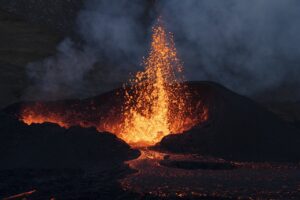Humans have increased the mercury in our atmosphere sevenfold
Research into the amount of mercury volcanos put into the atmosphere has helped uncover how much mankind has contributed since the beginning of the modern era.
The research, titled: Impacts of Volcanic Emissions on the Global Biogeochemical Mercury Cycle: Insights From Satellite Observations and Chemical Transport Modeling used new techniques to calculate how much mercury is emitted by volcanos, as this is by far the greatest natural source of mercury in the atmosphere.
Despite mercury being a problematic element, there’s incredibly little of it. A cubic metre of air, may contain a nanogram of mercury (a nanogram is roughly the weight of a single human cell).
So a team from Harvard John A. Paulson School of Engineering and Applied Sciences first used an improved method of determining the ratio of mercury to sulphur dioxide (SO2) in volcanic emissions, then used satellite observations of SO2 in volcanic plumes to calculate the amount of mercury being emitted.
The team then developed a new method to accurately estimate how much mercury is thrown into the atmosphere annually from volcanos and used that estimate — along with a computer model — to reconstruct the atmospheric mercury levels before man began adding to it.
They found that around the Middle Ages, the atmosphere contained about 580 megagrams of mercury. However, in 2015, independent research that looked at all available atmospheric measurements estimated the atmospheric mercury reservoir to be about 4,000 megagrams a sevenfold increase on the natural condition estimated in this study.
Emissions of mercury from coal-fired power plants, waste-incineration, industry and mining are the prime sources of all this extra mercury.
Elsie Sutherland, senior author of the paper said: ‘Methylmercury is a potent neurotoxicant that bioaccumulates in fish and other organisms — including us. Understanding the natural mercury cycle driven by volcanic emissions sets a baseline goal for policies aimed at reducing mercury emissions and allows us to understand the full impact of human activities on the environment.’
The researcher also modelled how volcanic mercury moves around the planet, finding that while mercury mixes into the atmosphere and can travel long distances, volcanic emissions are directly responsible for only a few percent of ground level concentrations in most areas on the planet. However, there are areas— such as in South America, the Mediterranean and the Ring of Fire in the Pacific — where levels of volcanic emissions of mercury make it harder to track human emissions.
Benjamin Geyman, a PhD student in Environmental Science & Engineering at SEAS and first author of the paper said: ‘In Boston, we can do our local monitoring and we don’t have to think about whether it was a big volcano year or a small volcano year. But in a place like Hawaii, you’ve got a big source of natural mercury that is highly variable over time.
‘This helps us understand where volcanos are important and where they aren’t, which is really useful for understanding the impact of humans on long-term mercury trends in fish, in the air and in the ocean. It’s important to be able to correct for natural variability in the volcanic influence in places where we think that influence may not be negligible.’


















